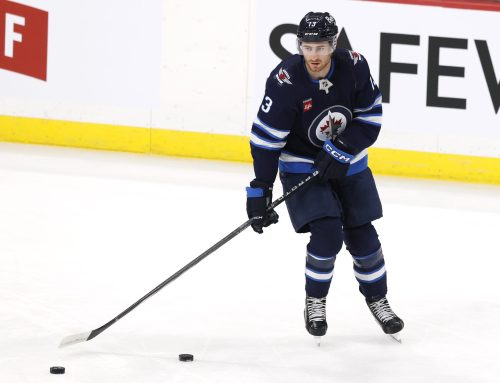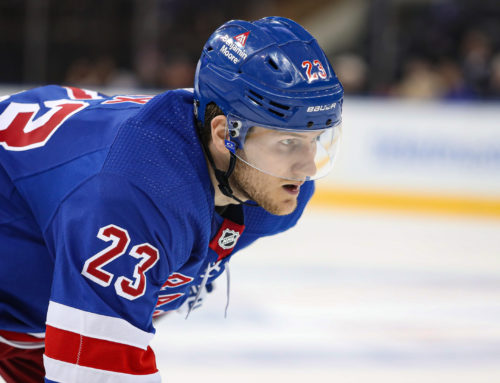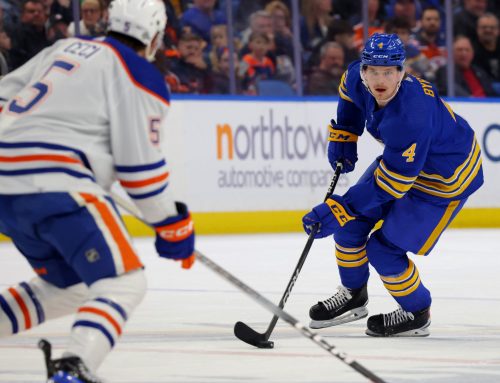
Though there’s obviously been a lot of digital ink spilled here and elsewhere on the signing of John Tavares, there’s a good reason for that: in the NHL, it is rare a player of his calibre isn’t on the team that drafted him into his 30s. Not in the cap era. Just look around the league: Sidney Crosby, Evgeni Malkin, Alex Ovechkin, Nicklas Backstrom, Jonathan Toews, Patrick Kane, Anze Kopitar, Drew Doughty, Steven Stamkos, Victor Hedman, Claude Giroux, Patrice Bergeron, Brad Marchand, Ryan Getzlaf, the Sedin twins, and on and on and on. For the ones on that list that aren’t in their post-30 seasons, they’re signed through them. We can argue about which of those players are on the Tavares level, but for those that aren’t, they at least have championships which factor in. Those superstars who do find themselves in new destinations in their early- or mid-20s are usually on rosters controlled by Peter Chiarelli. It’s why there’s so much coverage of Tavares and Erik Karlsson.
What can get lost sometimes, from a fantasy perspective, is the effect on the team that loses the player. Dobber covered how this will impact both Josh Bailey and Anders Lee when he wrote about the signing but one aspect I want to cover is the Islanders power play.
Barry Trotz had a heavily-used, 4F1D power-play unit in Washington and the Islanders had a successful top PP unit using this setup. I don’t suspect that will change. The two questions are: will Ryan Pulock supplant Nick Leddy? Who will replace John Tavares?
To answer the first question: not right away and maybe not at all. Even though Pulock showed well last year, Leddy maintained that top slotting and he should again to start the year. If the PP falters, maybe something changes, but don’t expect it out of the gate.
The second answer requires some more nuance.
Things were muddied a bit with the signing of Czech centre Jan Kovar on Monday (you can read about the impact of that signing here). I don’t think he gets a crack at the top PP unit to start the year but I also thought Vadim Shipachyov would be a 50-point player and he didn’t even play 50 minutes.
Who replaces Tavares is a matter of role and skill set. You don’t replace what Tavares can do internally, you just replace Tavares with a player who can fill his role on the power play.
More or less, Tavares had a net-front position last year. It wasn’t truly net-front in the vein of someone like Wayne Simmonds or Tomas Holmstrom because Anders Lee filled that role, but he was more of a below-the-line guy who would roll to the slot when Leddy or either of the wingers were looking for a net-front pass or shot. This is the shot chart of the Islanders top PP unit in 2017-18 (from HockeyViz.com) and you can see the overlap between Lee and Tavares:

The Islanders, then, need to replace Tavares with a guy who can play below the goal line as a facilitator while also getting to the front of the net for redirections, deflections, and close-distance one-timers. That is not Valtteri Filppula.
That is Brock Nelson.
Here is how the Islanders second PP unit stacked up. Eberle was in the Barzal role, Beauvillier took Bailey’s, Ladd took Lee’s, and Nelson had Tavares’s:

The following screenshots are taken from a game in mid-March against the Capitals. Here is the top PP unit in its normal setup at the end of the second period. You’ll notice Tavares in the mid-slot bumper role:

In that same game, here is the second unit on their PP setup. The first screenshot is the entry and Nelson is sneaking down low in case there needs to be a switch, which is the role Tavares would be assuming:

Once they’re setup, things are still a little disjointed because of the nature of the entry so we don’t have Eberle in his normal role, but once possession is established Nelson moves from the goal line to his bumper role:

It’s a pretty easy transition to make. No, Nelson is not Tavares. This is by no means equating the skills of the two players. But yes, Nelson did play the exact same role Tavares did on the second PP unit of the same team, something which Trotz would be very well-aware.
Pegging power-play units that are due for at least one significant change can be difficult, especially with a new coach incoming. Given Trotz’s PP setups and usage in Washington, though, and the pretty seamless role transition it would be for Nelson, that would be the obvious move.
The other option would be Barzal in the Tavares role and then have someone like Eberle take over Barzal’s old spot, which is possible, and would render the preceding 600-ish words useless.
*
What seems like an eternity ago, though it was a littler over a month in the past, these Ramblings covered specific targets for leagues that fantasy owners should be looking for. One Ramblings covered the number of goals, assists, and shots on goal for both forwards and defencemen that fantasy owners should look for (and how those numbers are increasing) while another covered real-time stats like hits and blocked shots.
Basically, those Ramblings just point out how certain categories like goals and shots have seen their averages and totals rise for fantasy leagues as the league-wide goal and shot rates increase, while others, like penalty minutes, have seen their prevalence decline. It has made 20-goal forwards less relevant and 80 PIM guys more relevant.
I said I would dig into position-specific totals and that’s on the docket for today.
For this specific post, we will be discussing only what occurred during the 2017-18 season. All data from Natural Stat Trick and we are using their positional alignments as well. Once Yahoo opens their lobby for the 2018-19 season, I will be using their positions, obviously.
Stats are compiled from the top-60 in points at each of centre, left wing, and right wing.
Centres
It shouldn’t surprise anyone that the pivots are still, by and large, the engines of offence up front. We had 18 centres manage at least 30 goals, four more instances than both wings combined. The top centres aggregated more goals, assists, and shots than their wingers. Again, remember we are not using Yahoo positions (yet), but it indicates to us that while a lot about the NHL is changing, some things remain the same.
These are the totals, averages, and standard deviations for the top-60 scoring centres in 2017-18:

A few things about these totals.
Being able to contribute across the board is really hard. Out of the 60 centres in the sample, just six had 26 goals, 40 assists, and 60 hits: Sidney Crosby, Steven Stamkos, Sean Couturier, Vincent Trocheck, Jonathan Marchessault, and Brayden Schenn. If we add another variable – minimum of 39 blocked shots – only Couturier and Trocheck qualify. To top it off, Trocheck is the only one to be average in all categories as Couturier fell just shy of the PIM cut-off.
Everyone who takes part in multi-cat leagues knows how much of a balancing act determining how much value a player can bring to a fantasy roster. Some guys bring goals and shots, some guys bring assists. Some guys bring real-time stats, some guys don’t. That’s why trade negotiations with fantasy owners always bother me.
Fantasy Owner: “But [Player Name] doesn’t give me help in [Four Categories]!”
Me: “Literally almost no one can be above average across the board.”
Fantasy Owner: “But I need a player who can be above average across the board.”
Me: *pulls the cilice a little tighter*
As far as pure point production is concerned, only five players found themselves more than one standard deviation above the mean in both goals and assists: Connor McDavid, Claude Giroux, Evgeni Malkin, Nathan MacKinnon, and Anze Kopitar. John Tavares was pretty close, falling five assists short. Aleksander Barkov needed five goals and an assist more, while Crosby just needed a few goals. All the same, only five made it.
There is a lot we can review but I just wanted to point out the top performers and just how hard it is to be good everywhere. Keep that second part in mind when someone is offering a trade. I’m begging fantasy owners to remember this (especially those in leagues with me).
Wingers
I want to include both wing spots in the same section because a common trope, depending on the season, is that one wing or the other is more advantageous in certain categories. Let’s go through the differences in 2017-18:
- The average left winger among the top-60 point-producing left wingers, as listed by Nat Stat, scored 21.3 goals. The average right winger among the top-60 point-producing right wingers scored 20.6.
- In that same sample, left wingers averaged 27.8 assists while right wingers averaged 28.2.
- In that same sample, left wingers averaged 181.9 shots on goal while right wingers averaged 178.3.
- If there was an edge, it was in the ‘gritty’ stats like PIMs, hits, and blocked shots where right wingers all had a decided edge.
To sum it up, left wingers scored more but right wingers produced much more in real-time stats.
Here are the totals, averages, and standard deviations for left wingers:

To compare, here are the totals, averages, and standard deviations for right wingers:

As far as the components of points are concerned, there really wasn’t a significant difference between what the left side produced compared to the right. The difference came in penalty minutes, hits, and blocks for the right wing. Depending on your league, there may not have been much of a difference here.
I just wanted to note two things.
First, for those who’ve read my Ramblings at least for the last couple months, you’ll remember my Ramblings about baseline production back at the end of May that I mentioned earlier. Those totals and averages in that column differ greatly from the totals and averages in this column. One reason is this sample of players is larger; only JT Miller, Rick Nash, and Ryan Hartman have dual eligibility, as listed by Natural Stat Trick, in my 180-player sample. That Ramblings had 156 unique players in the sample, this one had 177. Also, all the players in the Ramblings back in May were grouped into one homogenous sample, and we know centres are, generally, more productive than wingers. For those reasons, the baselines in that Ramblings were higher than this one where we split the forwards into their positions.
The second note is that there’s no real good way to devise a sample here. Fantasy hockey is, by far, the smallest of the Big Four fantasy sports. We could use ownership percentages in Yahoo or ESPN leagues instead of raw point production but then we worry about dead leagues, leagues where owners barely check their rosters, or leagues with unique setups. We could put a call out for people with specific setups to send us their season-beginning and season-end rosters, but I’m not sure we’d get enough sent in for it to be meaningful. That’s why I just chose point production as a way to get at which players are likely to be targeted in fantasy leagues.
When Yahoo and ESPN open their lobbies in September and we get confirmation about which players will qualify at which position, we will go over this again. Hopefully, at the least, this helped clear up the notion that one wing is vastly superior to the other for this year.





 FLA
FLA CHI
CHI NYR
NYR PIT
PIT L.A
L.A COL
COL CBJ
CBJ ANA
ANA WPG
WPG TOR
TOR MTL
MTL SEA
SEA S.J
S.J VAN
VAN BOS
BOS EDM
EDM
